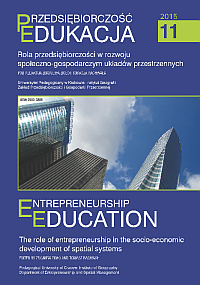Entrepreneurship in Eastern Poland – the evaluation of development potential using comparative analysis
DOI:
https://doi.org/10.24917/20833296.11.5Keywords:
benchmarking, development potential, Eastern Poland, entrepreneurshipAbstract
Changing conditions of the operation of economic systems increase the pressure on the effective management of their developmental process. This applies to both the strategic and operational managementlevel. The basis for decision-making is access to appropriately prepared management information, allowing for the correct determination of objectives and the assessment of the degree oftheir implementation. The aim of the article is to present a model description of entrepreneurship asone of the dimensions of strategic analysis relating to the potential of the economic system. It also explains the structure of the model and interdependencies between the individual elements thereof.Presented additionally is an example of the analysis of entrepreneurship comparing the regions ofEastern Poland. The measurement indicated above is described in the article from the perspective of the more complexelements of development potential, covering the potential of the economy, society and the environment.A method has been proposed for measuring enterprise level using selected measures basedon statistics from the Central Statistical Office. These were used in the comparative analysis, thusemploying the idea of benchmarking. This makes it possible to determine how the given dimensionis a strong or weak side of the system.The analysis was carried out using the example of the voivodeships belonging to so-called Eastern Poland. This area is characterised by territorial and developmental suburbanness. Owing to this, itconstitutes an interesting example for the analysis of developmental processes. The situation of thevoivodships has been presented against the background of the other regions in the country. Particularattention, however, has been paid to their situation in the context of the potential of the Mazovian, Malopolskie and Pomorskie voivodeships. These are regions in which relatively vibrant Metropolitansystems operate, significantly affecting the mobile elements of the potential of Eastern Poland,in particular, human and investment capital.
References
Aghion, Ph., Howitt, P. (1998). Endogenous Growth Theory. Massachusetts Institute of Technology.
Annoni, P., Dijkastra, L. (2013). EU Regional Competitiveness Index. Luxembourg: European Union.
Bański, J., Pantyley, V. (2013). Warunki życia we wschodniej Polsce według regionów i kategorii jednostek osadniczych. Nierówności społeczne a wzrost gospodarczy. 34, 107-123.
Burchard-Dziubińska, M. (2007). Ekologiczne determinanty rozwoju gospodarczego. W: R. Piasecki (red.), Ekonomia rozwoju. Warszawa: PWE
Chądzyński, J., Nowakowska, A., Przygodzki, Z. (2007). Region i jego rozwój w warunkach globalizacji. CeDeWu. PL Wydawnictwa Fachowe.
Churski, P. (2004). Rozwój regionalny w warunkach transformacji gospodarczej i integracji europejskiej. W: S. Ciok, D. Ilnicki (red.). Przekształcenia regionalnych struktur funkcjonalno-przestrzennych.
Regionalny wymiar integracji europejskiej. t. VIII/1, Wrocława: Instytut Geografii i Rozwoju Regionalnego Uniwersytetu Wrocławskiego, 31-45.
Czapiński J., Panek, T. (red.). (2011). Diagnoza społeczna 2011. Warszawa: Rada Monitoringu Społecznego.
Czupiała, J. (1994). Ekonomika innowacji. Wrocław: Wydawnictwo Akademii Ekonomicznej im. Oskara Langego we Wrocławiu.
Gieryszewska, G., Romanowska, M. (1998). Analiza strategiczna przedsiębiorstwa. Warszawa: Polskie Wydawnictwo Ekonomiczne.
Gorzelak, G. (2007). Strategiczne kierunki rozwoju Polski Wschodniej. W: Warunki rozwoju Polski Wschodniej w perspektywie 2020. Warszawa: MRR.
Keeley, B. (2007). Human capital. How what you know shapes your life. OECD.
Kurek, S. (2010). Przestrzenne zróżnicowanie poziomu rozwoju regionalnego w Unii Europejskiej w świetle wybranych mierników. Prace Komisji Geografii Przemysłu Polskiego Towarzystwa Geograficznego, 16, 87-104.
Malizia, E.E., Feser, E.J. (1999). Understanding Local Economic Development. Center for Urban Policy Research.
McCann, Ph., Ortega-Argilés, R. (2013). Smart specialization, regional growth and applications to European union cohesion policy. Regional Studies ahead-of-print, 1-12.
Miszczuk, A., Smętkowski, M., Płoszaj, A., Celińska-Janowicz, D. (2011). Aktualne problemy demograficzne Polski Wschodniej. W: Budowanie spójności terytorialnej i przeciwdziałanie marginalizacji obszarów problemowych. Ministerstwo Rozwoju Regionalnego, 96-105.
Pickton, D.W., Wright, S. (1998). What’s swot in strategic analysis?. Strategic change, 7, 101-109.
Porter, M.E. (2011). Competitive advantage of nations: creating and sustaining superior performance. Simon and Schuster.
Prusak, A., Stefanow, P. (2014). AHP – analityczny proces hierarchiczny. Warszawa: Wydawnictwo C.H. Beck.
Romer, P.M. (1994). The origins of endogenous growth. The journal of economic perspectives, 3-22.
Rusu, M. (2013). Smart specialization a possible solution to the new global challenges. Procedia Economics and Finance, 6, 128-136.
Saaty, T.L. (1990). How to make a decision: the analytic hierarchy process. European journal of operational research, 48(1), 9-26.
Sextona, D.L., Smilora, R.W. (red.). (1986). The Art and Science of Entrepreneurship. Cambridge: Ballinger Pub. Comp.
Strategia rozwoju społeczno-gospodarczego Polski Wschodniej do roku 2020. (2008). Rada Ministrów.
Strojny, J. (2012). Innowacyjne zarządzanie regionem, powiatem i gminą. Rzeszów: Politechnika Rzeszowska.
Downloads
Published
How to Cite
Issue
Section
License
Articles are published under the terms of the Creative Commons License (CC BY-ND 4.0; Attribution– NoDerivs).

